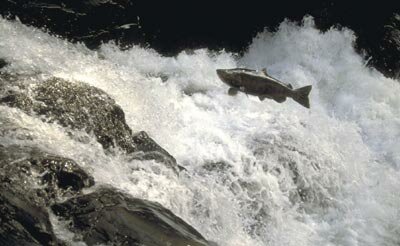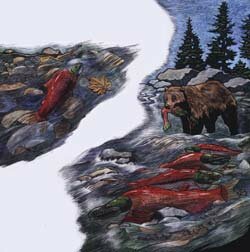|
|
Eagle Canyon: Salmon
Eagle Canyon | Taima the Eagle | Natural History
Full circle at the stream
 From a small, orange-colored egg the size of a pea to a 40-pound adult fish, the salmon goes through many transformations. Follow along with the life cycle of a typical Northwest salmon. A typical salmon can lay as many as 10,000 eggs. Only 300 of those eggs will grow into small fish, called fry. Only 40 of the fry will make it to the coast. Only 4 survive their years in the ocean and only 2 or 3 return home to spawn and start the cycle all over again. From a small, orange-colored egg the size of a pea to a 40-pound adult fish, the salmon goes through many transformations. Follow along with the life cycle of a typical Northwest salmon. A typical salmon can lay as many as 10,000 eggs. Only 300 of those eggs will grow into small fish, called fry. Only 40 of the fry will make it to the coast. Only 4 survive their years in the ocean and only 2 or 3 return home to spawn and start the cycle all over again.
- salmon eggs hatch in the redd
- fry grow in the stream
- fingerlings migrate downstream and journey to the sea
- spend years at sea — feeding, growing and storing nutrients from the ocean
- large adult salmon journey back up the river
- lay and fertilize eggs (spawn), then die
- get eaten and their nutrients are spread throughout the forest
Story of Illahee, the salmon
Small fry in a big river
Ever since she was just a few months old, Illahee was on the move. From her quiet creek in Idaho, she followed the currents west. Down the stream she floated. Into larger rivers. Around massive dams. Until one day, Illahee found herself at the mouth of the mighty Columbia. After getting used to the salt water, she headed into the ocean. Her journey to adulthood was about to begin.

Leaping Salmon (B. Forster)
A rocky start
Illahee's mother had swum against the current for weeks, driven by instinct back to her home stream. Using her powerful tail, she pushed aside gravel to create a nest of small rocks, called a redd. Then using the last of her energy, she laid her eggs deep among the rocks. Since most of the eggs would be swept away by winter floods or eaten by birds and other fish, it was important that they be as protected as possible. Her energy spent and mission complete, Illahee's mother died. But out of the thousands of eggs she laid that fall afternoon, a few survived — including Illahee.
 Keeping cool Keeping cool
With a flip of her tail, Illahee maneuvered herself into a bubbling rapid where she could rest and get oxygen. This was a favorite stretch of stream, with miles of clear, cold water. Trees and shrubs along the banks shaded the sun and provided bugs to eat. Riffles and rapids in the channel made frothy-white bubbles, adding oxygen to the water. And the downed tree along the bend created a deep, quiet pool for resting.
Clear Creek (Metro)
 The long way home The long way home
By the time she was four, Illahee had traveled more miles than most animals do in a lifetime. Now that it is time for her to lay eggs, her instincts tell her to swim back home. Back up the river, up the waterfalls and streams, returning to the fresh water spawning ground where she was hatched. Migrating salmon find their way home via instinct — with scent, taste and ocean currents all playing a part.
 Feeding the forest Feeding the forest
Illahee's life ended normally, as a salmon's does, after returning home and laying her eggs. Her body floated gently along the surface of the stream. Hundreds of salmon had washed up on the bank, just like they did every year at this time. Taima, and other birds of prey, depend on this cycle of life and death to feed themselves and their young. Spawned-out salmon leave their mark throughout the watershed, providing food for animals and enriching the soil.
Eagle Canyon | Taima the Eagle | Natural History
|


